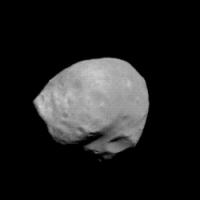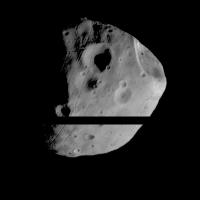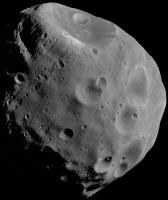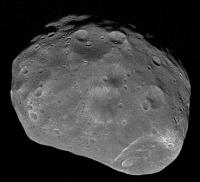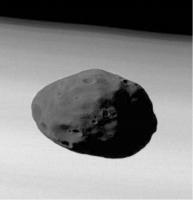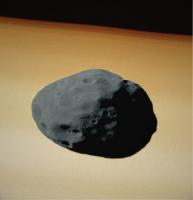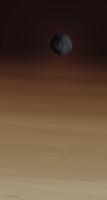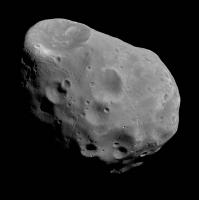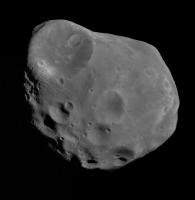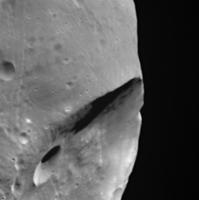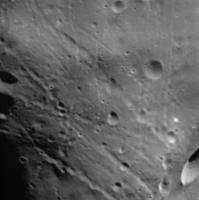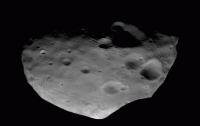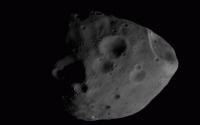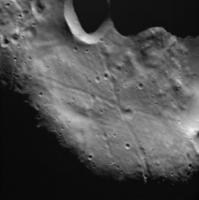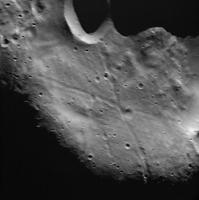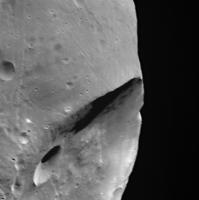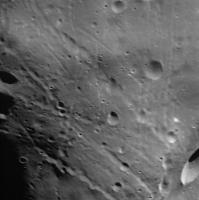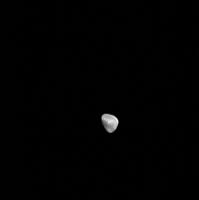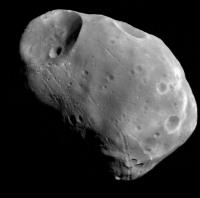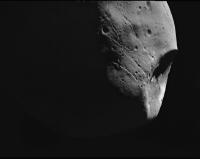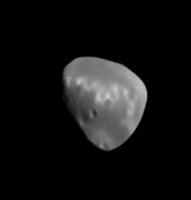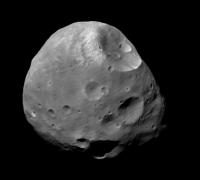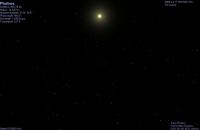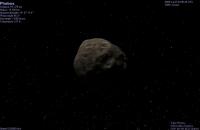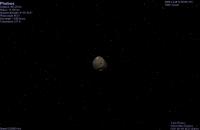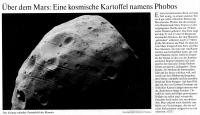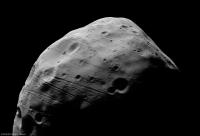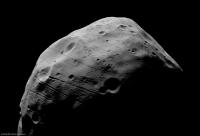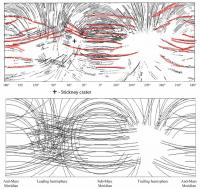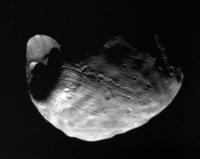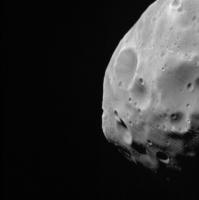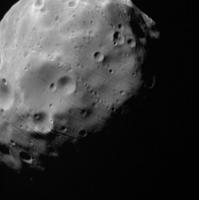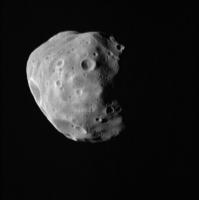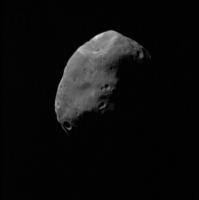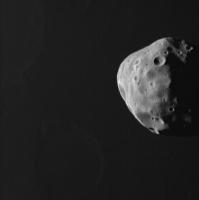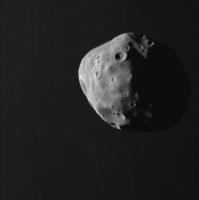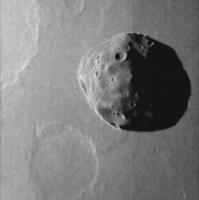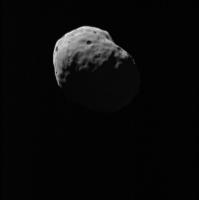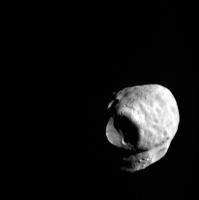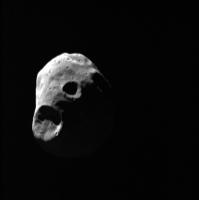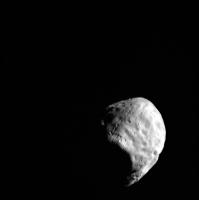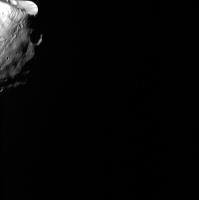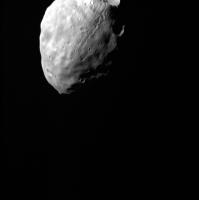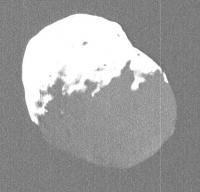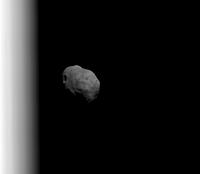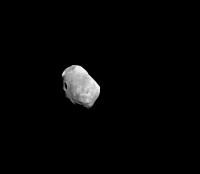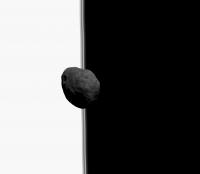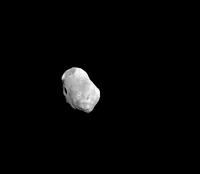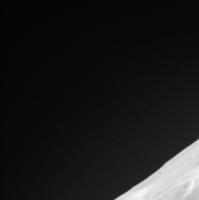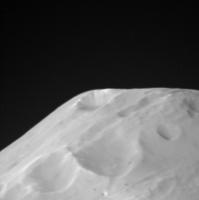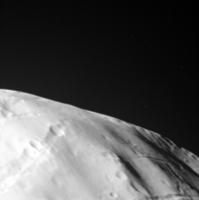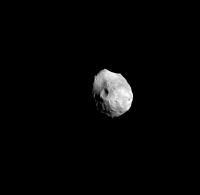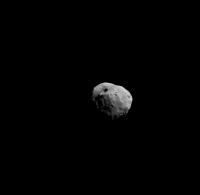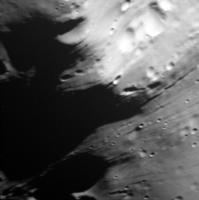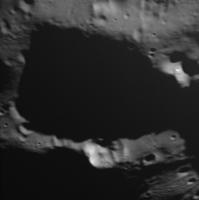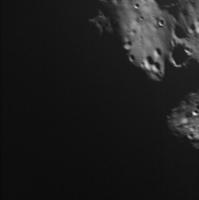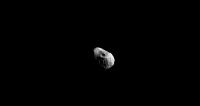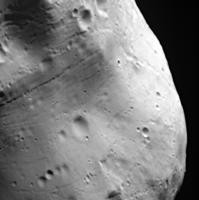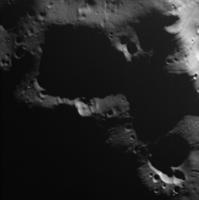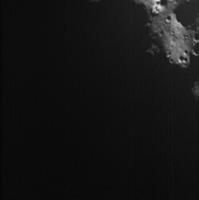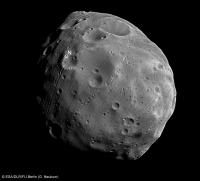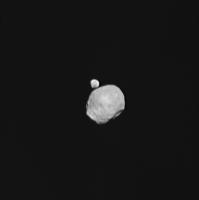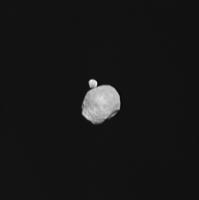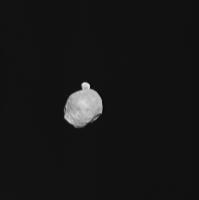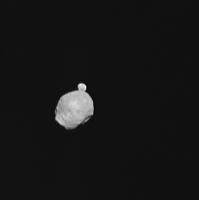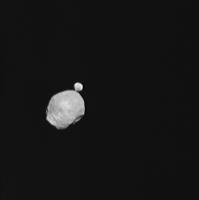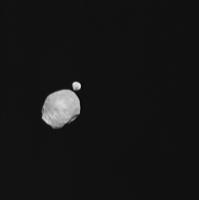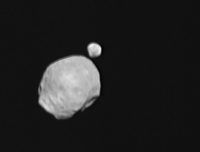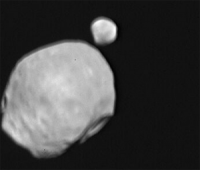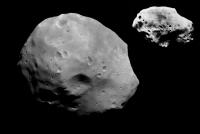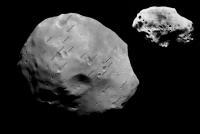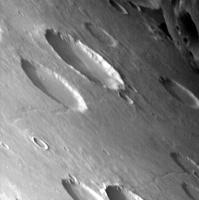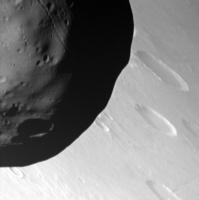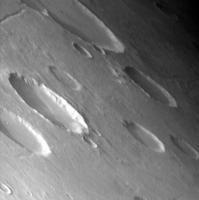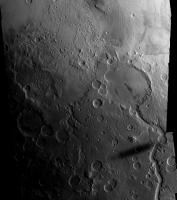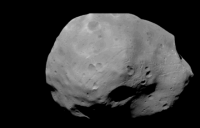Printable Version of Topic
Click here to view this topic in its original format
Unmanned Spaceflight.com _ Mars Express & Beagle 2 _ Phobos
Posted by: Sunspot Nov 11 2004, 11:46 PM
http://www.esa.int/SPECIALS/Mars_Express/
These images, taken by the High Resolution Stereo Camera (HRSC) on board ESA’s Mars Express spacecraft, are Europe’s highest-resolution pictures so far of the Martian moon Phobos.
http://www.esa.int/SPECIALS/Mars_Express/SEM21TVJD1E_0.html
Posted by: Phil Stooke Nov 18 2006, 05:49 AM
Here's a Mars Express Phobos image from orbit 1607- a distant view. There is a close view on this orbit, but I haven't got the patience to download 600 Mb of mostly dark sky.
Phil
Posted by: djellison Nov 18 2006, 07:12 AM
What is it with the PDS/PSA and their total hatred of Zip/Rar/GZ'ing files that actuall comrpess REALLY well...
At least the small bodies node have the right attitude for this stuff.
Doug
Posted by: PhilCo126 Nov 18 2006, 09:02 AM
Waaw thanks for sharing those!
![]()
Posted by: Phil Stooke Nov 18 2006, 01:31 PM
Mea culpa - I see now that the second image from that orbit, the 600 MB file, is of Mars, not Phobos.
Phil
Posted by: tedstryk Nov 19 2006, 02:13 AM
600 MB? The biggest Phobos images from that orbit are about 2 MB. Where were you looking? I was on the PDS Geosciences node.
Here are the two highest resolution images from this orbi (1607).
http://img134.imageshack.us/my.php?image=1607expresspda4.jpg
Posted by: Phil Stooke Nov 19 2006, 03:22 AM
I checked this after reading your question, Ted. The Data directory has the full res images, and for the largest image from that orbit it says:
Wednesday, April 26, 2006 6:49 AM 697587740 h1607_0009_nd2.img
697 Mb. But I was mistaken in thinking it was Phobos, I assumed that without checking - the second set of images from 1607 are of Mars. Even so, the largest Phobos image on that orbit, the nd2 image, is 9548940 bytes. Your images are the "super-resolution" images which are a lot smaller.
There are some very similar images of Phobos in orbit 1574 as well.
Phil
Posted by: Phil Stooke Nov 19 2006, 04:02 PM
- and another in orbit 1558, but this one is from orbit 1212, the nadir (nd2) image:
Phil
Posted by: Phil Stooke Nov 19 2006, 10:37 PM
I'm still exploring the Mars Express Phobos images. This, I think, is the highest resolution image yet, from orbit 756. The original file was 169 MB, but largely dark sky. I have played with the contrast a bit to brighten the terminator. Several blocks casting shadows can be found along the terminator.
Phil
Posted by: ugordan Nov 20 2006, 07:54 AM
Nice image, Phil. Where do the JPEG-ish artifacts come from, was this one lossy compressed before transmission?
Posted by: Phil Stooke Nov 20 2006, 02:20 PM
No, I compressed it severely to reduce the file size for posting on UMSF.
Phil
Posted by: dilo Nov 20 2006, 07:45 PM
Very impressive shot, Phil... resolution should be around 3m/pixel!
The file you posted is only 460k, I think is worth to re-post a less compressed version... please!
Posted by: dilo Nov 20 2006, 07:52 PM
sorry, wrong re-post.
Posted by: Phil Stooke Nov 20 2006, 11:57 PM
I will put the uncompressed image on an external website tomorrow.
Phil
Posted by: tedstryk Nov 21 2006, 12:14 AM
Phil
The best I could do with 16 bit lossless compression was over 9 MB!
Posted by: Phil Stooke Nov 21 2006, 01:33 AM
Good point, Ted - actually I'll be reducing it to 8 bit after a judicious contrast stretch (actually 2 different contrast stretches merged), and then saving it as a high quality jpg, so it will be compressed, but a lot less than my post.
Phil
Posted by: elakdawalla Nov 21 2006, 02:17 AM
Oh, that's a nice one, Phil!
Are you methodically posting every halfway decent Phobos image here or are you just making selections of your favorites?
--Emily
Posted by: Phil Stooke Nov 21 2006, 03:30 AM
I'm not being methodical, I'm just playing. I needed a break from more serious stuff. But I'll probably end up posting any decent Mars Express pics as I find them.
Phil
Posted by: Ian R Nov 21 2006, 11:29 AM
Good grief! Is it my imagination, or are there really two sets of grooves in the image that Phil just posted, intersecting at right angles? ![]()
How does this tally with the theory that the grooves were produced by interactions between Phobos and debris in orbit around Mars?
Ian.
Posted by: edstrick Nov 21 2006, 11:37 AM
Despite impeccible logic and analysis "proving" how the grooves were formed by impacting debris, I just don't believe it. Yah... one group from 10:00 clock to 4:00 clock and a second finer set from 1:00 clock to 7:00 clock angle. _AND_, roughly bisecting them at an angle of 5:30 to 11:30 clock angle is a non-groove linear splatter pattern that looks like it *IS* splatter-cratering from a jet of debris.
Posted by: Ian R Nov 21 2006, 11:45 AM
Good catch on the splatter pattern Ed. That certainly does look more like a crater chain from a debris or cometary impact.
Posted by: Phil Stooke Nov 21 2006, 02:20 PM
Here's a link to the higher quality Phobos image posted above. It's reduced from 16 to 8 bit, cropped and saved as a high quality JPG, so it is compressed but not too badly. The 16 to 8 conversion was done twice, once to favour dark areas, and the results merged using my secret sauce recipe. I'll keep this up here for a few weeks and then remove it so get it while it's hot.
Phil
http://instruct.uwo.ca/geog/136a/hrsc756_phobos.jpg
Posted by: elakdawalla Nov 21 2006, 05:48 PM
I've mirrored it here...
http://s3.amazonaws.com/planetary/10212/hrsc756_phobos.jpg
--Emily
Posted by: volcanopele Nov 21 2006, 06:36 PM
Phil, do you know the pixel scale on that particular image from orbit 756?
Posted by: Phil Stooke Nov 21 2006, 06:55 PM
The PDS label says 5.9 m/pixel. and roughly 5000 pixels across 30 km seems to support that value.
Phil
Posted by: dilo Nov 21 2006, 09:03 PM
Thanks for the great image Phil, I hope one day you will reveal your secret sauce recipe... ![]()
(I was wrong about image scale because I estimated it using Phobos mean radius instead of diameter)
Posted by: Phil Stooke Oct 14 2007, 02:18 PM
Here's a nice new Phobos image from Mars Express, orbit 3909:
Phil
Posted by: scalbers Oct 14 2007, 02:29 PM
Out of curiosity, how are things going with mapping of Phobos? The best global map I've seen is the USGS airbrushed version. FWIW, my mapping software is approaching the point where I can consider utilizing more general shape models, vs a simpler triaxial ellipsoid.
Posted by: Phil Stooke Oct 14 2007, 05:04 PM
I should have added to my previous post - it came from one of the abstracts at the ESA Mars Conference - see thread under Conferences. Willner et al., in the Friday Workshops.
Mapping - there has been no serious work since Viking. I've been saying for years that I'll make a new global mosaic with the best images, but other things have prevented me. But I will certainly do so when Phobos-Grunt flies, or if CSA's PRIME gets funded. The abstract above refers to a new global shape model, which will help improve the next round of mapping.
Phil
Posted by: tty Oct 14 2007, 05:10 PM
Now that is interesting. How do you get a splatter pattern/crater chain on a body with essentially zero gravity? It certainly can't be by stuff just falling back to the surface. Anything moving slowly enough to fall back on Phobos probably wouldn't be able to crater a marshmallow.
I suppose a string of debris might stay together well enough to hit Phobos on a subsequent orbit but it seems rather unlikely. It seems at least as likely to be debris coming from an impact on Mars itself.
Posted by: elakdawalla Oct 14 2007, 06:53 PM
Wow, Phil, that's a really cool image, thanks for pointing it out!
--Emily
Posted by: Stu Oct 14 2007, 09:04 PM
... and add a bit of colour, just 'cos it's Sunday night and there's nothing on telly until Medium comes on...
Posted by: nprev Oct 15 2007, 03:00 AM
Great stuff, Phil & Stu!!! Now I know exactly how Phobos must have appeared to the crew of the spacecraft Rolling Stone as it approached Phobos in Heinlein's immortal novel...absent the industrial complexes and filled landing berths, of course... ![]()
Quick inspiration:
we sense therefore we are
unmanned and alone
solitary robots peer deeply into the Unknown
seeing, tasting, hearing that which no human has yet known,
like a splash of water or blast of radiation
on tender skins
We, safe in the cradle, see vistas dreamed of
yearned for, in our infant dreams
by generations denied their future by tumult,
by the restless and capricious nature of our species
by priorities, set too often by
those who cannot see far horizons,
even through eyes of silicon, gallium arsinide, feed horns and reflectors...
blindness is inexcusable
as the spectrum of the Universe unveils itself, reluctantly,
as bigger than our minds
what challenge, what wonder, can possibly compare?
we must see, at least
in order that someday we may touch
Posted by: Pygmee Oct 15 2007, 08:29 PM
Hey Phil, could you tell me where you got the pictures from orbit 3909, because I do find only the raw images until the orbit 3160 on the ftp://psa.esac.esa.int/pub/mirror/MARS-EXPRESS/HRSC...
Thanks a lot
Posted by: Phil Stooke Oct 15 2007, 08:41 PM
I found it in the place mentioned in post 30, above.
Phil
Posted by: elakdawalla Oct 17 2007, 04:57 PM
Here's the direct link to the http://www.rssd.esa.int/SYS/docs/ll_transfers/project=MarsEXPRESS&id=2778599.pdf (PDF).
--Emily
Posted by: scalbers Oct 19 2007, 03:43 PM
Shall be interesting to see what shape model results Willner et al. are going to present at the November conference.
Seeing that image I wonder who launched that potato into low Mars orbit anyway ![]() ?
?
Posted by: elakdawalla Oct 19 2007, 03:45 PM
Dr. Willner said I'd need to ask Neukum directly for permission to post that other image, but he pointed out one that had been released on the Web in February (apologies if someone else already posted this elsewhere):
http://www.dlr.de/DesktopDefault.aspx/tabid-3432/3681_read-7819/gallery-1/gallery_read-Image.1.2995/
--Emily
Posted by: Stu Oct 19 2007, 07:12 PM
Wow, that's a gorgeous picture of Phobos, thanks for the link Emily... that one passed me by, somehow...
Posted by: ugordan Oct 19 2007, 07:23 PM
That picture was around for quite a while now: http://www.unmannedspaceflight.com/index.php?s=&showtopic=3946&view=findpost&p=84812
Posted by: Phil Stooke Nov 11 2007, 12:13 AM
Here are a couple of Mars Express HRSC images of Phobos, from the PDS courtesy of G. Neukum. They have had a bit of extra processing in my usual manner to brighten the terminator area.
Phil
Posted by: scalbers Nov 11 2007, 12:16 AM
That's something with three different orientations of grooves I can see in the top image...
Posted by: Tayfun Öner Nov 11 2007, 08:17 AM
It is already gridded, it will be easy for Phil to make us a new model and map. ![]()
Posted by: ilbasso Nov 11 2007, 06:48 PM
At first glance, I thought we were looking at it through a screen door.
Posted by: Decepticon Nov 11 2007, 09:43 PM
![]()
Posted by: peter59 Feb 16 2008, 05:03 PM
The High Resolution Stereo Camera (HRSC) on Mars Express is not the best instrument.
Orbit 3802, Phobos, image h3802_0003_sr2
Orbit 3802, Phobos, image h3802_0004_sr2
Posted by: djellison Feb 16 2008, 05:19 PM
HRSC itself is great, but the super resolution bolt-on camera from which those two frames came from has never achieved good focus.
Doug
Posted by: peter59 Feb 16 2008, 06:39 PM
Mars Express (MEX) release #2.
February 14, 2008
http://pds-imaging.jpl.nasa.gov/Admin/resources/cd_mex.html
Orbit 3310, Phobos, image h3310_0000_s22
Orbit 3310, Phobos, image h3310_0000_s12
Posted by: peter59 Feb 16 2008, 06:50 PM
Another high (??) resolution image.
Orbit 3769, Phobos, image h3769_0004_sr2
Posted by: djellison Feb 16 2008, 09:09 PM
Orbit 3769, Phobos, image h3769_0004_sr2
The SR2 dictates it's from the super resolution camera, bolted on to HRSC, and thus suffers the same issue I mentioned previously.
Doug
Posted by: algorimancer Feb 16 2008, 10:57 PM
I tried running Helicon Focus software on a few images. Looks like a combination of motion smear + out of focus, but the dominant effect seems to be motion smear. Due to the jpeg artifacts it's a little difficult to do a good job of this, but here are some images with the motion smear (somewhat) corrected. I think that if I had uncompressed versions of the images then I could pull quite a bit of fine detail from them.
Posted by: ugordan Feb 16 2008, 11:13 PM
I don't think it's motion smear, more like noncircular PSF due to out of focus deformity in some part of the optics. It gives an appearance of vertical motion smear. It would probably be possible to do a proper deconvolution if we knew the PSF exactly (say by imaging a star), but as I recall the amount of defocus isn't constant either.
Posted by: Phil Stooke Feb 17 2008, 01:37 AM
It certainly is not motion smear, but it does look like it because there is a 'double exposure' effect. Regardless, they are still nice images in other respects, and are being used to improve the shape model of Phobos (The other HRSC images are less useful for that because they are from a scanning rather than framing camera). The top one just above is inside Stickney. These pics come in sets of 4 or 5 making up strips across the surface, and would make nice mosaics.
Phil
Posted by: peter59 Feb 17 2008, 07:34 AM
'Double exposure' effect.
Orbit 3196, Deimos, image h3196_0005_sr2.
Posted by: peter59 Feb 17 2008, 07:46 AM
Orbit 3802 - images h3802_0003_sr2, h3802_0005_sr2, h3802_0005_sr2
Orbit 3802 - image h3802_0000_s12
Posted by: algorimancer Feb 17 2008, 02:05 PM
I'll take your word on that. Incidentally, what is "PSF"?
Posted by: djellison Feb 17 2008, 02:51 PM
the S12 image is pushbroom.
PSF = Point Spread Function. i.e. the contribution of surrounding pixels to the pixel in question. With accurate info on that, you can subtract it all back out again..ish...roughly.
Doug
Posted by: tedstryk Feb 17 2008, 06:08 PM
Here is a quick attempt. There does seem to be motion blurring in some of the data, almost as if it is a double exposure with one of the two slightly smeared in a direction almost but not quite perpendicular to the direction of the double exposure offset.
Edit: The bit of motion blur I mentioned could also be explained by optics being slightly out of alignment. Normally, the difference between the two is obvious, but this is too slight for that.
Posted by: mgrodzki Feb 17 2008, 09:00 PM
i am wondering the nature of these phobos and deimos releases… are these just additional images they captured last year but we just hadn’t seen them until they released the full sets of data?
Posted by: tedstryk Feb 18 2008, 01:01 AM
They were, for the most part, not in official releases, but were in the raw data release. Much of this has been available via ESA's PSA for a long time.
Posted by: mgrodzki Feb 18 2008, 01:52 AM
oh, the sudden activity in this thread lead me to believe this was a new batch of materials.
are the full “global” views posted here composites that some of you have stitched or are they just full views snapped by MExpress?
Posted by: GravityWaves Jul 16 2008, 01:02 PM
Mars Express to rendezvous with Martian moon
http://www.esa.int/SPECIALS/Mars_Express/SEMVGAWIPIF_0.html
16 July 2008
Scientists and engineers are preparing ESA’s Mars Express for a pair of close fly-bys of the Martian moon Phobos. Passing within 100 km of the surface, Mars Express will conduct some of the most detailed investigations of the moon to date.
The series of fly-bys will take place between 12 July and 3 August. During the second encounter, the spacecraft will fly within 273 km of the surface. Six days later, Mars Express will close to within just 97 km.
Although the Red Planet itself has been studied in detail, very little is known about the origins of its moons, Phobos and Deimos. It is unclear if the moons are actually asteroids that were captured by Mars’s gravity and never left its orbit. Another possibility is that Phobos and Deimos are actually surviving planetesimals, bodies which formed the planets of the Solar System. They may also be remnants of an impact of a large object on Mars.
As Mars Express closes-in on Phobos, the data gathered will help scientists answer these questions.
Posted by: Phil Stooke Jul 16 2008, 05:14 PM
"As it flies by at a distance of 97 km, Mars Express will image areas of Phobos that have never been glimpsed before. "
... by Mars Express. The whole surface of Phobos was imaged by Viking.
Oh for a Deimos encounter.... there's a world we really do need new images of.
Phil
Posted by: tedstryk Jul 16 2008, 06:08 PM
Yes, particularly the trailing hemisphere.
Posted by: dvandorn Jul 17 2008, 03:57 AM
... by Mars Express. The whole surface of Phobos was imaged by Viking.
And some people got offended when I mentioned the ESA tendency towards "little lies"?
If it ain't exactly the truth... *sigh*...
-the other Doug
Posted by: Hungry4info Jul 27 2008, 10:59 PM
Does anyone know when those images from the 97 km flyby will be made available?
Posted by: nprev Jul 28 2008, 12:06 AM
Uh.... <Ahem!> Well, um...that's a pretty good question, and all I'm gonna say.
Posted by: elakdawalla Jul 28 2008, 12:14 AM
Agustin Chicarro (project scientist) told me they were supposed to be downlinked Friday, and that there should be some images released on Monday.
--Emily
Posted by: Stu Jul 28 2008, 11:19 PM
00.12... bye bye Monday...
Maybe tomorrow...
Posted by: tedstryk Jul 29 2008, 01:22 AM
He said Monday, but he didn't say which Monday ![]()
Posted by: Hungry4info Jul 29 2008, 03:45 AM
AAAhhh! Ha ha! They tricked us! =P ...
Posted by: nprev Jul 29 2008, 04:32 AM
Hungry, just so you know (if you don't already), releases from ESA can be a bit erratic for a whole lot of known and unknown reasons that I definitely don't want to get into for reasons of forum decorum and that have been extensively discussed previously. Gotta wait & hope, is all. ![]()
Posted by: Hungry4info Jul 29 2008, 04:35 AM
Oh yes, I'm certainly aware. ESA's public relations has always been a source of agitation for me.
I think I've heard perhaps two or three bits of news from Venus Express in it's whole mission. I've seen perhaps two pictures from the mission.
Posted by: nprev Jul 29 2008, 04:37 AM
You'll find lots of company here, then...
Posted by: Stu Jul 29 2008, 01:02 PM
Just heard back from the ESA Media office...
"We are still waiting for the material, but expecting to receive the first images by the end of the day or tomorrow.
We will publish them on the web (link below) as soon as possible (tomorrow or Thursday the latest).
http://www.esa.int/esaSC/index.html"
Posted by: 3488 Jul 29 2008, 07:55 PM
unnecessary quoting removed
Thanks Stu,
I was beginning to wonder also. Does anyone know what the resolution of the images at closest approach will be, 1 metre per pixel, better, worse? Hopefully we'll get some more insight as to where Phobos camefrom.
Captured type D asteroid?
Formed around Mars?
Formed from impact ejecta from Mars?
My bet is still option 1, despite the difficulties with explaining orbital mechanics, but I still think, Phobos is as alien to Mars as the spacecraft we have sent.
It will be interesting to compare the new Phobos imagery with the NEAR / Shoemaker spacecraft imagery of similar resolution of asteroid 433 Eros.
Perhaps Mars Express could do similar with Deimos? Comparisons with the MARSIS & multispectral imagers / spectrometers of the two would be most fascinating.
Andrew Brown.
Posted by: CAP-Team Jul 29 2008, 09:53 PM
Using spice kernels (for the spacecraft, Mars and Phobos) I tried to simulate the Mars Express Phobos flybies.
Underneath the images of how Phobos would approximately look like at closest approach.
The field of view in these images is 30 degrees (I don't know what field of view Mars Express has).
17 july 2008 (273 km)
23 july 2008 (97 km)
28 july 2008 (361)
I wonder how accurate Celestia will be
Posted by: djellison Jul 29 2008, 11:49 PM
width of the HRSC swath is about 12 degrees - covering 5000ish pixels.
Doug
Posted by: bear10829 Jul 30 2008, 11:57 AM
A photo of Phobos quoted to have been made during the 93 km flyby last week was published
in the Nature & Science section of todays Frankfurter Allgemeine Zeitung, a major German newspaper.
G. Paul, who is frequently writing about space topics there, gave some general information about
the moon and a hint, that the photos cover the proposed Phobos-Grunt landing site.
This might be an indication that some release of data is near.
Best,
Oliver
Posted by: nprev Jul 30 2008, 12:06 PM
If I read that correctly, the headline says "Over Mars: A Cosmic Potato Named Phobos"? Hilarious!!! ![]()
Posted by: Dominik Jul 30 2008, 12:41 PM
Yes, the translation of the title is correct ![]() .
.
Posted by: lyford Jul 30 2008, 03:14 PM
So can we nickname Phobos-Grunt "SPUDnik?" ![]() *ducks*
*ducks*
Posted by: 3488 Jul 30 2008, 03:38 PM
http://www.dlr.de/en/Portaldata/1/Resources/portal_news/newsarchiv2008_4/grunt_01_phobos_flyby.jpg.
Images appearing now.
Andrew Brown.
Posted by: volcanopele Jul 30 2008, 04:00 PM
Here is the link to the press release:
http://www.dlr.de/en/DesktopDefault.aspx/tabid-1/86_read-13161/
Posted by: Hungry4info Jul 30 2008, 04:08 PM
http://www.dlr.de/en/DesktopDefault.aspx/tabid-1/86_read-13161/
The image they provided there looks pretty distorted (The 3.74 Mb image). Do they intend to clean that up?
Posted by: elakdawalla Jul 30 2008, 04:45 PM
I don't know about distortion -- Phobos looks pretty distorted in general; I can tell you from experience that it can be really hard to tell whether you have an oblique perspective or if an image has been unequally stretched. But I have a different question. There are two image releases that lack annotations. I thought that maybe they were the two views that had been combined to create the stereo image. But it appears that they are in fact the same image, stretched differently, and it seems that there was a gap in the image, some kind of data dropout, that was handled differently between the two images. In one the gap was closed, making an obvious seam; in the other, the gap was filled by duplicating pixels. I think that's what's going on anyway -- do others agree? The two pictures are
http://esamultimedia.esa.int/images/marsexpress/401-20080729-5851-6-na-1a-Phobos-Flyby_H1.jpg
and
http://esamultimedia.esa.int/images/marsexpress/401-20080729-5851-6-na-1b-Phobos-Flyby_H1.jpg
Odd.
--Emily
Posted by: elakdawalla Jul 30 2008, 04:53 PM
The opposite of a usual activity: take apart an anaglyph to get its separate frames and voila, two more HRSC images of Phobos. Here's the red channel:
And the blue channel:
Enjoy!
--Emily
Posted by: ilbasso Jul 30 2008, 05:08 PM
Interesting, the relatively small number of the tiniest craters. The dust layer must be mighty thick.
Really cool anaglyph on the home page - it really leaps off the screen at you!
Posted by: hendric Jul 30 2008, 10:34 PM
I just had a really dumb idea, looking at that moon again. I was noticing how much it resembled the rocks around Opportunity at Victoria, and I started thinking...Hmm, what if those grooves were caused by differential micrometeoroid weathering due to layers? They do resemble at a macro scale the aeolian cross bedding we've seen before. That would add weight to the "Phobos is a chunk of Mars" idea!
Posted by: jasedm Jul 31 2008, 12:31 PM
The best (for me) explanation I've heard for the grooves so far was highlighted http://www.planetary.org/blog/article/00001391/ as being the result of Phobos sweeping up ejecta in chains from Martian impacts. Scroll down on the linked article to see a computer simulation which is a good match to the observed grooves.
But looking at the latest pictures, they seem to be far too straight and of regular width to be secondary crater chains - looking much more like collapse features to my untrained eye.
The mystery remains....
Posted by: Paolo Aug 21 2008, 07:42 AM
In Astronomy & Astrophysics: http://www.aanda.org/articles/aa/abs/2008/34/aa09787-08/aa09787-08.html
Posted by: Harkeppler Aug 21 2008, 09:52 AM
Mayby grooves on phobos seem not to be due to secondary impacts from asteroid impacts on Mars; they are too defined and regularly for that. These computer simulations seems to give only the trajectory of the ejected masses but the the width of the shower. And there are too much of these grooves and they are too regularly placed. This counts for some effects connected with material resistance against stress forces per length unit.
Especially, one set of grooves seems to be more or less concentric or better: coaxial along the Mars-anti-Mars-axis and can be explaned easily with tidal effects. The "craters" along the grooves may be simply sinkholes, especially because there are no ejecta. The other set of grooves (here highlighted in red) is nearly perpendicular to the other one and can be formed earlier by the same way; a large impact may have altered phobos orientation by chance and after that tidal fractures occure in a new set. So, that older bunch of grooves is orientated around the old Mars-anti-Mars axis of Phobos. Here:
http://www.planetary.org/blog/article/00001391/
or here
http://www.lpi.usra.edu/meetings/lpsc2006/pdf/2195.pdf
You can see the both sets, but you need another cartographic projection to see the old set as a concentric/coaxial one as well as the other.
Both groove sets are not (the old one) or not well (the new one) converging to two points but slicing phobos more like a cut potato. Here, the non-sperical shape of phobos and cartographic problems with this fact should be considered; the pseudo-convergence is an articfact of the cylindrical projection!
I would also consider that Phobos had been in an elliptic orbit first, so diffential stresses du to the tidal force change between apoareum and periareum and libration (nodding) effects due to the constant rotation period and the inconstant orbital angular velocity would have forced a result. A large impact, mayby the Stickney forming impact, would have altered the meanwhile circular orbit to an elliptic one again and it altered Phobos spin and orientation. So a second set of grooves came to existence.
You may recognize that the younger grooves, which are mostly sharper defined and smoother than the older ones (red) cross through them (and not opposite) which will give a hint which groove set was the former one.
The Stickney-impact itsself may be "buffered" by the weak material itsself, like the craters on asteroid Mathilda, and does not harm the whole structure. It is like shooting a projectile in styrofam...
It would be interesting to look for some grooves on several other moons like Amalthea; in the Saturnian system so much dust maybe hide features like that on the innermost moons.
Posted by: SteveM Aug 21 2008, 09:48 PM
The main concern is with the fine details of Phobos' orbit.
Steve M
Posted by: charborob Oct 16 2008, 07:23 PM
Interesting article about Phobos on the ESA website, based on the recent flyby:
http://www.esa.int/SPECIALS/Mars_Express/SEM8MUSG7MF_0.html
Posted by: tanjent Oct 18 2008, 03:35 AM
In the article just quoted by charborob, there is an animation of Mars Express being diverted from its orbit during a close pass by Phobos. The interesting thing about this simulation is the way MEX returns to its original orbit after the deviation. It looks kind of like the maker of the simulation has added the symmetric plot of a normal distribution to the original unperturbed track of the spacecraft. Is this really how it would happen, or would the spacecraft experience a permanent change in its orbit due to the small gravity assist derived from Phobos? Observatoire Royal de Belgique must know a lot more than most of us about orbital mechanics, but maybe in this case they are pulling our legs and expecting us not to notice?
Posted by: peter59 Nov 6 2009, 02:47 PM
I checked "forgotten" Mars Express archive and I stated that this year Phobos has been photographed several times. Unfortunately, the quality is not stunning.
and Phobos over Mars craters.
Posted by: Phil Stooke Nov 6 2009, 02:55 PM
I like the last two transit images! More close passes would certainly be nice, especially if they showed the Phobos-Grunt landing region better.
Phil
Posted by: charborob Nov 6 2009, 04:17 PM
Transit image modified to show the Martian surface better.
Posted by: elakdawalla Nov 6 2009, 04:57 PM
Why is the Martian surface so dark in those transit images? Is it because we're on the nightside of Mars' terminator?
Posted by: Phil Stooke Nov 6 2009, 05:06 PM
The shading suggests that's not right.. not near-terminator either. Maybe it's the filter?
Phil
Posted by: ugordan Nov 6 2009, 05:39 PM
Couldn't the skylight provide some illumination, mainly from the west, even past the terminator? Didn't one of Dawn's Mars flyby images capture a similar scenario?
Posted by: vikingmars Nov 12 2009, 02:48 PM
Peter 59, please, could you tell us the orbit # of those pics, so that we can retrieve the original pics ? Thanks in advance
Posted by: peter59 Nov 12 2009, 06:16 PM
Orbit number is contained in the names of the attached images:
H5984_0004_SR2, H6042_0005_SR2, H6217_0005_SR2, H6128_0003_SR2
This is a great honor for me to talk with someone who has played a significant role in the Viking mission. Words of respect.
Posted by: vikingmars Nov 12 2009, 08:40 PM
[quote name='peter59' date='Nov 12 2009, 07:16 PM' post='149916']
![]() Oh... thanks a lot, Peter, I do not deserve so much after all those years, but I like very much your Phobos pics selections ! Thanks again for sharing those with us
Oh... thanks a lot, Peter, I do not deserve so much after all those years, but I like very much your Phobos pics selections ! Thanks again for sharing those with us ![]()
Posted by: vikingmars Nov 12 2009, 09:30 PM
![]() ...And, Peter, here is your image fully colorized. Enjoy !
...And, Peter, here is your image fully colorized. Enjoy !
Posted by: elakdawalla Nov 12 2009, 09:49 PM
The craters in the background sure look weird! This isn't a snapshot, of course; time as well as distance are covered along the long axis of the image, and the spacecraft was clearly doing something odd as it was setting up to track Phobos. But I don't understand what was happening to make the craters appear smeared in a stepwise fashion.
Anyway, cool colorization, Olivier.
Posted by: djellison Nov 12 2009, 09:59 PM
I wonder if it's a bit like the way Mars stops, goes backwards, then carries on, night to night in the night sky.
Posted by: Phil Stooke Nov 12 2009, 10:29 PM
Retrograde craters - I think you've got it, Doug.
Phil
Posted by: ormstont Nov 24 2009, 12:10 PM
That's a really stunning image! Which orbit is the colourised shot from? I can look up our attitude profile and see what might be causing the crater distortion (although I think you've already guessed it!).
Posted by: Stu Dec 11 2009, 11:18 AM
"Phobos & Deimos visible in same image for first time"
http://www.dlr.de/en/desktopdefault.aspx/tabid-1/9600_read-21513/
Posted by: PhilCo126 Dec 11 2009, 11:45 AM
Remarkable footage to say the least although I expected Phobos to pass even faster throught the image:
Posted by: djellison Dec 11 2009, 11:52 AM
Images every 0.1s - slowed significantly in that animation - not surprising it comes across as 'slow'.
Posted by: ElkGroveDan Dec 11 2009, 12:20 PM
That statement needs a qualifier:
http://apod.nasa.gov/apod/ap031024.html
and
http://photojournal.jpl.nasa.gov/catalog/PIA06337
(sorry Stu it seems I've been picking on your posts a lot lately, nothing personal.)
Posted by: ustrax Dec 11 2009, 12:37 PM
"For the first time, the two tiny Martian moons Phobos and Deimos have been photographed together in a high-resolution image sequence."
Posted by: ngunn Dec 11 2009, 12:49 PM
If someone fancies putting two copies of the animation together with a one frame time difference that might work as a crosseye 3D animation.
Posted by: cndwrld Dec 11 2009, 04:03 PM
Here is the ESA page on the images: http://www.esa.int/SPECIALS/Mars_Express/SEMDOE7JT2G_0.html
"For the very first time, the martian moons Phobos and Deimos have been caught on camera together. ESA's Mars Express orbiter took these pioneering images last month. Apart from their ‘wow’ factor, these unique images will help the HRSC team validate and refine existing orbit models of the two moons."
More information about how they got the images are on the page. Very cool sequence.
Posted by: elakdawalla Dec 11 2009, 06:36 PM
Thanks for the tip, Dan.
Posted by: tedstryk Dec 11 2009, 07:36 PM
The image caption says "http://www.dlr.de/en/DesktopDefault.aspx/tabid-1/9600_read-21513/gallery-1/gallery_read-Image.8.12354/." It seems like whoever wrote the press release failed to understand the significance of the last three words.
Posted by: ngunn Dec 11 2009, 11:07 PM
Well I can confirm that consecutive frames from this image sequence make very good 3D pairs, so I'm going to have one more go. This time not a suggestion but a request - on bended knee - a 3D animation please!
Have we ever had a 3D animation from spacecraft images here? Maybe it would be a first.
Posted by: charborob Feb 1 2010, 02:45 PM
Mars Express is scheduled to make the closest Phobos flyby at 50 km on March 3.
http://www.esa.int/esaMI/Mars_Express/SEMDUGSJR4G_0.html
Posted by: JohnVV Feb 2 2010, 01:22 AM
i thought that phils deimos was based on that ( oops not from pairs but the outline )
http://www.psi.edu/pds/resource/oshape.html
http://www.psi.edu/pds/asteroid/EAR_A_5_DDR_SHAPE_MODELS_V2_1/data/m2deimos.tab
my vid.
http://www.youtube.com/watch?v=g7A4RaaOzho
an artistic enhancement to the above shape model m2deimos.tab
Posted by: Phil Stooke Feb 2 2010, 01:32 AM
My earlier work on Deimos was the construction of a global photomosaic. The shape model it was based on was by Peter Thomas of Cornell, the leading person in this kind of work, and it used Viking images. The shape model is not ideal - a large region near 270 W longitude has only ever been seen in one image, so no stereo for shape modeling at all. We badly need a future mission to provide new imaging of Deimos.
Posted by: JohnVV Feb 2 2010, 06:52 AM
i thought it was from the Viking images
mine is a hand drawn height map converted to a 3ds model
well a mission there will solve the problem
Posted by: climber Feb 22 2010, 08:46 PM
From AW&ST next issue: "Mars EXpress has begun a series of new flyby of Phobos...at its closest encounter, on Mars 3 the probe will come to within 50 km. (31 mi.) of the Martian moon..."
Posted by: charborob Feb 25 2010, 02:23 PM
The latest post on the http://webservices.esa.int/blog/blog/7 has this information:
"New webpages went online today allowing anyone to download data from the digital terrain model of Phobos created by the EuroPlanet project..."
The links for downloading the DEM is at the bottom of http://europlanet.dlr.de/node/index.php?id=214.
Animated flyover anyone?
Posted by: JohnVV Feb 25 2010, 09:42 PM
i just answered a question on this over at shatters.net
and a very quick pds to png convert of
base_dtm_phobos.pds
[attachment=20838:base_dtm...obos.cub.png]
the above image WAS "normalized " 0 to 256
a better one
from the pds > cub ( ran fx on it os the values are from 1098 to 6585) > exported to 16bit tif > to rgb normalized png
[attachment=20839:base_dtm_phobos.png]
Posted by: dmuller Feb 25 2010, 11:08 PM
Nice one ...
I haven't found published information on the exact flyby times, here's what I've calculated using the SPICE kernels I could find:
07Mar 01:28:34UT 109km
28Feb 16:24:32UT 227km
25Feb 11:52:32UT 399km
I havent come across the 5th flyby yet. It may well be after 9 March which is when the current trajectory data (available to me) runs out.
I will update the MEX realtime simulation at http://www.dmuller.net/mex with these dates in due course.
Posted by: peter59 Mar 3 2010, 09:19 PM
Why the Mars Express camera (HRSC) would not be taking images at closest approach? It turns out that there are three reasons.
http://webservices.esa.int/blog/post/7/1038
Posted by: Explorer1 Mar 3 2010, 09:52 PM
Hey, it's not that bad. Remember Deep Impact, which also wasn't allowed to take photos at closest approach, because of the risk of debris damaging the camera? We still learned a lot about Tempel 1 anyway!
Posted by: ugordan Mar 3 2010, 10:02 PM
It wasn't?
Posted by: CAP-Team Mar 3 2010, 10:29 PM
Why not risk the camera, at that time no follup-mission was planned.
Ofcourse, the impact still had to be photographed.
Posted by: djellison Mar 3 2010, 10:37 PM
It wasn't that taking photographs was prohibited - it was that the spacecraft had to orient itself to protect itself during the closest approach because of cometary particles etc, and then continue departure imaging thereafter. It was protecting the entire spacecraft so it could finish its mission, not the camera.
http://www.nasa.gov/mission_pages/deepimpact/timeline/index.html
"Flyby spacecraft enters shield mode"
Posted by: Explorer1 Mar 4 2010, 02:09 AM
Yeah, that's what I meant. The end result was the same though. No more photos or other data until it was well on its way past closest approach and 'looking back'.
Posted by: dmuller Mar 4 2010, 06:22 AM
The actual closest flyby altitude was ultimately 67km due to an engine overburn ... http://webservices.esa.int/blog/blog/7
New SPICE kernels are in as well, taking us to 20Mar and hence the remaining close flybys. Just to add confusion, the table below states UTC times and not ephemeris times as my earlier table:
2010-03-10 05:59:37 Close Phobos flyby at 288km. Relative speed 10,406km
2010-03-13 10:31:41 Close Phobos flyby at 477km. Relative speed 10,330km
2010-03-16 15:03:48 Phobos flyby at 664km. Relative speed 10,262km
2010-03-19 19:35:58 Phobos flyby at 850km. Relative speed 10,201km
Posted by: Lightning Mar 4 2010, 09:12 PM
Some early pictures are released ![]()
This image was taken 656km across.
Posted by: stevesliva Mar 4 2010, 10:17 PM
The grooves are beginning to look more like crater chains.
Posted by: djellison Mar 4 2010, 11:19 PM
LOL indeed - the flybys so far have not even included imaging.
The image you direct link to without citation is from here
: http://www.esa.int/SPECIALS/Mars_Express/SEMIPX6K56G_0.html
Which then links to here
: http://www.esa.int/SPECIALS/Mars_Express/SEMIPX6K56G_1.html
Where we find out
So no - they've NOT released early pictures because that's an 18 month old , and they've not even TAKEN any with this new flyby sequence yet.
Posted by: JohnVV Mar 4 2010, 11:33 PM
i see a lot of those chains and these do not look like them
I will go look for some and post pics .
Posted by: Hungry4info Mar 4 2010, 11:56 PM
They couldn't take images in this sequence because MEX had to be in "passive mode" for accurate tracking for the Phobos-gravity experiment.
IIRC, this flyby was over the night side, so the images wouldn't have been too enlightening anyway.
Edit:
peter59 already said that.
Posted by: stevesliva Mar 5 2010, 12:08 AM
I will go look for some and post pics .
It's okay-- I know the old debate, which is why I'm curious what they look like at smaller scales. Apparently that photo wasn't it, although I did think they were planning shoots outside the radio science portion of this flyby.
Posted by: tasp Mar 5 2010, 04:26 AM
It's late, so take this thought experiment as woolly night owl speculation;
We apparently are seeing 'ring residue' on Rhea's surface from a rather tenuous, but seemingly fairly organized orbiting system. Now imagine for the moment, a mini sub-moon (like maybe in the 1-2km range) placed ~~1000km above Rhea's equator. What does the 'ring residue' look like if it 'splats' onto the 1-2 km sub-moon ? (or more precisely, what does the sub-moon look like after it is splattered)
(I think the size of the sub-moon might need to be closely constrained, I am trying to minimize shepherding effects)
Plausibly Phobos-like, or completely un-Phobos like?
Could dust (crud) knocked off Deimos organize to the extent of the Rhean residue, apparently detected by Cassini's MIMI instrument, on it's way spiraling down to Mars ?
Posted by: JohnVV Mar 5 2010, 05:38 AM
well it is an old one at that
-- idea from above post
?????????????
what if .... a ring ( at mars) was at the same orbit as Phobos
and the moon eat-up the ring .
and the ring material carved out the lines - like from a sand-blaster
i have NO evidence, but...
Posted by: Lightning Mar 5 2010, 11:38 AM
Oups, so ashamed to have been fooled so easily by a press release.
Thanks a lot for your attention.
Posted by: peter59 Mar 5 2010, 01:02 PM
Date Altitude (km) * Instruments used during flyby
16 February 991 PFS, SPICAM, ASPERA
22 February 574 PFS, SPICAM, ASPERA
25 February 398 PFS, MARSIS
28 February 226 PFS, MARSIS
03 March 50 MaRS, ASPERA
07 March 107 HRSC, OMEGA, MARSIS, SPICAM, ASPERA
10 March 286 HRSC, OMEGA, MARSIS, ASPERA
13 March 476 HRSC, SPICAM, PFS, ASPERA
16 March 662 HRSC, SPICAM, PFS, ASPERA
19 March 848 HRSC, SPICAM, PFS, ASPERA
23 March 1341 Not used
26 March 1304 HRSC, SPICAM, PFS,
Posted by: Hungry4info Mar 5 2010, 04:09 PM
John W,
I would expect the deposition of ring material to build mountains, not canyons (see Atlas, Pan).
Unless it was less of a ring and more of an asteroid belt.
I agree they look like them. (image from MRO below)
The crater chain hypothesis fails to explain why the linear features on Phobos are in series of parallel lines. There are sets of parallel lines pointing one direction, and sets of parallel lines pointing another direction.
What about tidal fracturing (with loose material filling the gaps, falling in a funnel-like pattern to produce the observed crater shapes) followed by reorienting of the moon by some mechanism, then continued tidal stress in a new orientation.
As for the two criss-crosing linear features in the image below, I have no idea.
Posted by: peter59 Mar 5 2010, 06:04 PM
New massive batch (2010-02-17) - orbits 6402-7094
Orbits: 6551, 6637, 6745, 6758, 6757
Posted by: Hungry4info Mar 5 2010, 06:13 PM
Too much noise for my limited skills to bring out anything notable on the night side.
Posted by: Bart Mar 5 2010, 06:38 PM
I thought there was a theory that the sets of parallel lines were caused by ejecta from impacts on Mars?
Posted by: Hungry4info Mar 5 2010, 06:54 PM
How would that explain the closeness of the craters (Surely, the impactors would have spread out)? How would that explain the presence of the linear features all over Phobos? What about the lines that cross and curve?
Posted by: JohnVV Mar 5 2010, 09:33 PM
Hungry4info
a late night thought
but i do think they are the result of tidal stress
[attachment=20947:12_13phobos1.png]
i have been working on something else and came across a "crater chain "
luna north pole but ...
http://www.imagebam.com/image/ab9b4470788964
Posted by: peter59 Mar 6 2010, 01:34 PM
Absolutly stunning images from orbit 6906 (21.05.2009)
2592 x 2248 pixels
5184 x 4488 pixels
1008 x 1018 pixels
Posted by: Phil Stooke Mar 6 2010, 01:44 PM
"I thought there was a theory that the sets of parallel lines were caused by ejecta from impacts on Mars? "
There was - still is in some minds, but I've never felt it was very satisfactory. My preferred idea is that the grooves are the surface expression of jointing (families of intersecting fracture planes) in the interior, possibly caused by large impacts, though not necessarily Stickney (the south polar depression is probably a very old crater larger than Stickney). They might also be caused by pressure release after excavation from the interior of a parent body, and opened by later impacts. The porosity we now expect can be explained as caused by open jointing.
Phil
Posted by: peter59 Mar 6 2010, 02:41 PM
Another stunning images from orbit 6916 (23.05.2009)
5184 x 5040 pixels
1008 x 1018 pixels
Posted by: peter59 Mar 6 2010, 02:43 PM
..... and from orbit 6926 (26.05.2009)
5184 x 2728 pixels
1008 x 1018 pixels
Posted by: Hungry4info Mar 6 2010, 04:35 PM
Wow, ESA just won a little more of my heart.
Posted by: Antdoghalo Mar 6 2010, 10:11 PM
What about tidal fracturing (with loose material filling the gaps, falling in a funnel-like pattern to produce the observed crater shapes) followed by reorienting of the moon by some mechanism, then continued tidal stress in a new orientation.
As for the two criss-crosing linear features in the image below, I have no idea.
The fracture hypothesis Could be more likly because Phobos IS a rubble pile and surely tidal force from Mars might along with the larger impacts have caused some of the spaces between the rocks to be filled in by small particles and like a sinkhole here in Florida the above rock then collapsed to fill in the new space vacated by the particles that filled in the cracks and formed the holes on its surface.
The recent flyby could have been to determine if this is true.
Posted by: djellison Mar 6 2010, 10:51 PM
Don't get too excited - these are all old images - May '09 mostly.
Posted by: Hungry4info Mar 6 2010, 11:04 PM
Even so, they are new to me. ![]()
Could the tidal fracture interpretation of the linear features on Phobos explain why some of the close lines are slightly curved and intersect each other? Or why the linear features are seen across the entire moon? I was browsing through the Phobos images I've so far downloaded over the years and came across this one. It hurt my confidence in the tidal fracture hypothesis.
Posted by: peter59 Mar 7 2010, 06:17 AM
Photos taken at the end of May 2009 and published in February 2010. It's an absolute record for ESA. It is cause for excitement and enthusiasm.
Posted by: CAP-Team Mar 7 2010, 08:20 AM
Looks like some large boulders rolled or bounced on the surface of Phobos, possibly disappearing in space afterwards
Posted by: bk_2 Mar 9 2010, 01:48 AM
Hi, I've been lurking here a while but at last I've been prompted to post.
The old images of Phobos set me thinking again about the grooves. I worried about them for months a few years back. Now I’ve had a new idea. The trouble with the ploughing through debris theory [John B Murray 2006] is that at orbital altitude there won’t be strings of ejecta narrow enough to make those regular grooves, it has to involve some fine ring material. But if Phobos was ever orbiting in a ring it would have the same velocity as the ring material in which it orbits, it wouldn't have ploughed through anything. So here’s the new idea. If, during the period when Mars had these putative rings, Phobos had a more elliptical orbit, but in the same plane as the rings, it would have come screaming in and ploughed right through the rings at periapsis on each orbit. To create the grooves, Phobos would have had to be tidally locked as it is now, to present the same face to the flak, though it must have wobbled a bit, going by the angles of the grooves. (cf. Murray)
Perhaps the rings even formed in the same event that created Phobos, whether impact or capture, presuming there was enough material dislodged by the tidal disruption if it was the latter.
I understand that the orbits of smaller particles and dust circularise and flatten out relatively quickly by collisions, while a large chunk like Phobos, would slowly circularise by tidal forces, so if they formed together there would be a time when the orbits were different. Another point is that a common source for Phobos and the rings would be most likely to put them in the same plane.
The involvement of rings of fine material is crucial. How else could a groove form that extends the length of the flank in serene uniformity, than by collison with a narrow linear obstacle like a ring edge on? There are some less well defined grooves that are clearly crater chains, like the five little craters almost identical in size, equally spaced in a line parallel to one of the huge smooth trenches. These could have been caused by irregularities in the rings, bits where larger and fewer ring particles accumulate.
Obviously the rings didn't persist for long, they aren't there now, and Phobos must have disrupted their structure by it's regular visits. But they lasted long enough to leave the grooves.
Does it have any merit?
Posted by: Explorer1 Mar 9 2010, 03:51 AM
Would there even be any evidence on the Martian surface of rings? They'd have to be large enough to make it to the surface, and if the atmosphere was thicker in those days than there'd be no way of knowing.
We'll get new photos in a couple days anyway though.
Posted by: Shaka Mar 9 2010, 06:08 AM
I'd have to say it tickles my fancy, but I don't know enough about orbital dynamics to pick out showstopper flaws.
Certainly it strikes me as more in keeping with the overt appearance of the grooves, than mechanisms invoking tidal stresses or big impacts on Mars.
What you do need to explain is the quite uniform width of particular grooves, together with the significant variations in width between grooves. The widest grooves are clearly chains of individual impact craters that overlap to a limited extent. Your hypothesis requires impacts with a family of objects of relatively large and uniform size. Small craters are not evident. The narrower grooves aren't so easily resolved into individual craters, but are presumably the result of numerous impacts with families of smaller objects; again quite uniform within grooves, but with negligible 'contamination' by the large objects forming the wide grooves. Somehow you have to postulate a size distribution of objects within your rings that either spatially or temporally sorts out size classes.
I'll be hornswoggled if I can readily visualize that, but an orbital mechanics guru might be able to. It would be groovy if we could work out the sequence of deposition of the grooves. My first-glance WAG would be that the narrowest grooves deposited earlier than the widest, but I wouldn't bet my surfboard on it.
Best of luck with your "ring-whacker" hypothesis!
Posted by: JohnVV Mar 9 2010, 06:30 AM
i just tossed out the idea as a late night idea . I was thinking of my bad brakes and in the past they have ground the disks and drums .
seeing as Phobos is just a ball of rubble ( like a chocolate chip cookie - with almonds)
the stresses from Apogee/Perigee ( .3 Km) small but add in meteor hits ( Stickney) and it is not a surprise that there are there .
Posted by: Phil Stooke Mar 9 2010, 03:05 PM
I'm pleased to see new discussions of the formation of these unusual grooves. The ring hypothesis is unique, as far as I know. My concern would be that it would have to account for grooves in multiple orientations, including north-south oriented groove sets crossing the north pole from 90 to 270 longitude.
Also, don't forget there are grooves on Gaspra, Ida and Eros... they are not as numerous or organized as those on Phobos, but they still exist. Do we need separate explanations for grooves on different bodies, or can one be found that works for all of them?
Phil
Posted by: Phil Stooke Mar 9 2010, 07:15 PM
I am just starting a new photomosaic map of Phobos, using the best modern images. Positional control will be from the Viking mosaic made by Damon Simonelli, Peter Thomas et al. at Cornell in the 1990s, but this will be 3x the resolution and using much better images. I'll post sections of it as they are completed, in a new thread. Maybe it will help the groove origin discussion, though I'm doing it for other reasons.
Phil Stooke
Posted by: JohnVV Mar 9 2010, 09:01 PM
hi phil i found that the new isis shape model of Phobos i did was of not much use on the "low" res images
but if you want it let me know
Posted by: bk_2 Mar 10 2010, 08:56 AM
I would like to elaborate a little on my "ring-whacker" hypothesis (thanks Shaka for the monicker).
Although the grooves generally extend from the leading face along the flanks of Phobos, they are not all parallel. They vary widely near the apex, they even cross eachother. But along the flanks they are nearly parallel as far as I can see, varying by ten degrees or so at most.
The explanation could be that as Phobos slammed into the rings on each pass, it altered the distribution of mass in the main body, changed its shape a bit. Being tidally locked, its orientation would have to change to accommodate the new shape, and on the subsequent pass it would be travelling in the new orientation, presenting a slightly different face to the flak. The shape seems to have been constant enough to keep the same hemisphere in the direction of travel, all the grooves peter out as they approach the trailing hemisphere, but that's about all you can say. Near the leading apex they are confused, with some grooves cutting others. (This presents an ex-archaeologist like me with an interesting example of stratigraphy, the groove that does the cutting must be later than the one cut.)
But the compelling evidence for this hypothesis is the morphology of the grooves. The best of them are smooth trenches a hundred meters wide and twenty kilometers long, straight as a Roman road, impervious to the terrain traversed, crossing crater walls even into the hollow of Stickney. How could such a feature arise? A ring would do it. A flat thin ring, met edge on. It would be like slicing the top off your boiled egg with a knife, only this knife didn't penetrate. The one good example of rings we have in the Solar System is Saturn's glory. I have read that they are of the order of ten meters thick. That sounds about right for a hundred meter wide trench. If Mars' putative rings were similar to Saturn's, they would have been ideal for trench-gouging.
Phobos' orbital velocity is currently about 2Km per second. If we consider that during the time of its elliptical orbit, its orbital velocity at periapsis was double that, while the ring particles were orbiting at it's current velocity, the delta v was about the same, 2Km per second. The impact of millions of tiny particles, in a ten meter thick layer, at 2Km/s would create just such a trench. The escape velocity of current day Phobos is less than 12m/s. Much of the ejecta from the impacts must have departed the scene, but there may also have been accretion. Either way, the distribution of mass would have been altered.
Some of the grooves are obviously crater chains, where the impactors were much larger than particles of dust. These are in much the same orientation as the long smooth grooves. I read that the particle size in Saturn's rings varies from ring to ring, and that some like the Anthe Ring Arc are limited in extent. During the formation of Mars' putative rings there may have been similar variation and irregularity, particularly with the disruption by Phobos. The larger pieces of debris from the formation event had to go somewhere. Maybe there is a mechanism in the formation of rings from a debris cloud that sorts out the particles by size. If so, the nice regular chains of similar sized craters at similar spacing could be the result of collision with such a size-sorted ring or arc. (I'm afraid I'll have to go and read some more about the theory of ring formation.)
That's all I can think of now.
Posted by: Phil Stooke Mar 10 2010, 01:58 PM
I don't think the reorientation idea would stand up to a dynamical analysis, but it's ingenious and worth studying. A couple of other things to think about... would the process dig grooves or build ridges? (i.e. is the impact velocity large enough to do what you want?) And what about topographic shadowing? At the edge of the disk the particles would hit the forward-facing surfaces on ridges or crater walls, but not the leeward sides of them. Can we find examples like that?
Phil
Posted by: Shaka Mar 10 2010, 09:36 PM
No telling what we might find in a new high-resolution photomosaic map of Phobos! ![]()
Posted by: bk_2 Mar 11 2010, 10:12 AM
Phil, I don't think I see any examples of topographic shadowing. It's something I hadn't thought about.
On refelction I have to concede that the shape-shifting idea is a bit lame. It doesn't look as though much matter was lost or accreted by the groove formation, at least not a significant proportion of the mass of the main body. If you filled the ridges alongside the grooves into the hollows it looks like it would restore the ungrooved surface. Not enough to change the centre of gravity significantly.
But collision with a ring could affect its orbit. Remember that this hypothesis rests on the idea that the orbit of the main body and the rings were co-planar. That in itself is a big ask, and maybe it is answered by a common original impact. Even so, co-planar is not that well-defined in a rubble cloud trying to settle down into rings. Phobos' orbit could have been perturbed sufficiently on each pass at periapsis to nudge the next pass a few kilometers higher or lower, the sort of separation we see between the grooves. Like aerobraking, if you get the angle just a bit wrong, it send the craft off-course.
If Phobos ploughed through the rings with its equator above or below the plane, making grooves in the middle latitudes, the path of the grooves should trace the intersection of the ring-plane and the surface, they should follow a contour. I have been trying to verify this using the folded paper model of Phobos published on this site some time back, but the angular shape is too crude, and anyway I couldn't figure out how to glue those last seams. A high-res digital 3D model would be really helpful. But if it proves true that the rings trace out the contour of a plane intersecting the surface, it would clinch the ring-whacker theory in my opinion. What else could Phobos hit that's flat and a few meters thick?
The other problem is the criss-cross pattern of grooves on the leading apex. It seems that the orientation about the direction of travel varied between passes, as if Phobos was oscillating about the gravitational minimum, mainly in latitude. We see something like that in the libration of the Moon, it wobbles in its orbit. The angles of intersection of the grooves means Phobos must have wobbled quite a bit, around 90 degrees. Perhaps the wobble was amplified by off-centre passes.
Does anybody know where to find a high-res digital 3D model?
Posted by: Hungry4info Mar 11 2010, 01:01 PM
JohnVV has provided us with this spectacular model for Celestia.
http://celestiamotherlode.net/catalog/show_addon_details.php?addon_id=1359
Posted by: imipak Mar 11 2010, 08:49 PM
Extremely interesting idea, bk_2! Even I can grasp it and visualise it without understanding orbital dynamics. Therefore I think it's elegant, minimal, and retrospectively obvious - all attractive properties. (Then again, I have a notorious tin ear... ![]() ) A few questions that occurred to me reading the very interesting discussion:
) A few questions that occurred to me reading the very interesting discussion:
1. What would a ring/moon impact look like? I suspect it shouldn't be pictured as a series of point-events - multiple distinct impacts, releasing a burst of energy and creating a crater. Instead there'd be a continuous rain of impacting particles at any given point. (A curtain of dust raining down in a ruler-straight line... what an image!) How would the end-result of lots of small impacts in one spot compare to one big one, assuming the same (cough) aggregate mass for the particles as for the monolithic impactor? Does the outgoing ejecta interact with the incoming ring material?
2. How do the masses of the moons where groove-like structures have been observed compare to those of moons without grooves? Larger objects might have more energetic internal processes renewing the surface, or perhaps there's an upper bound to the gravity of moon. (Wouldn't stronger gravity fields mean the ring particle orbits would be rapidly disrupted?) I'm thinking of the wake images of the Saturnian shepherd moons and trying to visualise the dynamics with a larger shepherd, but I'm handicapped by ignorance of the calculus; and ISTR that these phenomena can be startlingly unintuitive!)
3. [EDIT: remove some of the foolishness.]
4. With respect to the crossing / intersecting angles of the grooves (and come to think of it, parallel grooves are presumably a special case of the general phenomena: something about the relative motion of ring and moon must have changed for the track to have moved across the moon's surface):
- perhaps the groove-creation isn't continuous. Perhaps it was only one orbit of the moon in 100,000 intersects the ring. Or 1000 consecutive orbits, but with each episode happening only every 10^2, 10^3, 10^4 years.
6. Perhaps the groove-creation happened before Phobos was tidally locked?
7. Why are the grooves discrete structures, rather than very broad bands? If the moon/ring aspect angle was changing, presumably it would happen at a steady state. If every orbit the moon makes intersects with the ring, whilst it's rotational axis is slowly precessing (or it continuous slowly rotating prior to being tidally locked), that would make the impact zones broad strips, or the shape of two very thin triangles touching at the apex. Instead, we see distinct grooves of similar widths, separated by apparently virgin surface typical of any common or garden rubble-and-dust-pile. To me this suggests that either:
i. whatever changes the location of the ring's intersection with the mooon was a sporadic, short-duration event; or,
ii. that the actual ring/moon intersection that caused the rings
8. As I understand it, Saturn's rings are largely fine dust and ice grains - 10^-3cm -- 10^2 cm or thereabouts. The masses of particles in rings resulting from impacts on Mars, or from tidal disruption of passing rubble piles, might be expected to have a different mass distribution curve.
9-99: ..?
Posted by: JohnVV Mar 11 2010, 09:16 PM
Hungry4info but that cmod of phobos ( i have other formats) is a sculpted model .
done by hand and not made with 3d stereo ( or lidar) data
this is the same argument i have with t00fri
I am artistic and he is 100% scientific
Posted by: bk_2 Mar 12 2010, 08:38 AM
@imipak
I told that to my five-year-old grandaughter, "elegant, minimal, and retrospectively obvious". She laughed like a drain.
But to the matter.
> 1. What would a ring/moon impact look like?
Dusty, I expect, ejecta from the buzz-saw of the ring would have obscured the view. Would it have interfered with the incoming ring? It depends on the trajectory of the ejecta. If you drop a pole flat in the pool, the splash it makes is a sheet on either side, angled away from the direction of impact. I expect the impact of the thin, colimated ring would do something similar, most of the ejecta would get clean away, from the incoming ring and the feeble gravity, and return to the rubble cloud.
> 4. ... Perhaps it was only one orbit of the moon in 100,000 intersects the ring
If the rock of this idea is sound, the grooves formed in the early period when the orbits of the main body and the rings were different, but co-planar. I think the series of grooves were lain down in short order, relatively speaking, before the rings were totally dispersed by the repeated passes. So I think the intersects would have been on each pass.
> 6. Perhaps the groove-creation happened before Phobos was tidally locked?
What we are discussing is the grooves that we can see on the current surface. There have been no significant changes in the shape of the moon since they were laid down, no scarps or groove discontinuities. So the c.o.g. hasn't changed much since the grooves were laid down. It had to be tidally locked in its current shape to present the same leading hemisphere. My point is that the tidal lock equilibrium could have been disturbed by an intersection. If the ring hit in the northern middle latitudes I can imagine it would rock it back on its heels, and set it rocking about the balance point.
> 7. Why are the grooves discrete structures, rather than very broad bands?
Yes, that's tricky. It depends on the angular velocity of the moon around the axis of its direction of travel at the time of intersection. How quickly did it wobble, or nod up and down around the balance point? That would depend on how close the c.o.g. was to the geometric centre, how unbalanced it was, and the inertia of the gross mass. I have to propose, without any visible means of support, that the nod was slow enough that the impact of each individual ring was not smeared out by the shifting terrain. But maybe the ring system consisted of many narrow rings, and intersection with each was brief enough to leave a narrow groove even though the moon was nodding.
> 8. As I understand it, Saturn's rings are largely fine dust and ice grains - 10^-3cm -- 10^2 cm or thereabouts.
Sure, but Saturn's rings are mainly ice and have a different origin. I don't know what it was, but it definitely wasn't an impact on the planet below. An impact on Mars would have thrown up a lot of rock, in chuncks of various size. They might have all been pulverized to dust but it seems unlikely. I suspect the proto-groove, the crater chains, are attributable to the remnant rocks.
There, some of them answered.
Posted by: Phil Stooke Mar 13 2010, 02:07 PM
I hear hints that the Phobos images will be released on the 15th.
Phil
Posted by: elakdawalla Mar 13 2010, 09:51 PM
All right, then we're going to have to divide forces. Which of us UMSFers is going to go after the Phobos pics, and which are going to dive into the deep end of the LRO PDS release? ![]()
(*raising my hand for Phobos*)
Posted by: volcanopele Mar 13 2010, 11:49 PM
I'll be at a meeting but it might give me a chance to do some light processing on the netbook with Gimp ![]()
My vote is for Phobos, since I doubt I could do much with the LRO images from that machine...
Posted by: JohnVV Mar 14 2010, 12:01 AM
seeing as i already have a working folder for phobos and mro isis files
I would also need to install the lro isis files
And these things are BIG
Posted by: Phil Stooke Mar 15 2010, 11:06 AM
http://www.esa.int/SPECIALS/Mars_Express/SEMK17CKP6G_0.html
Phil
Posted by: CAP-Team Mar 15 2010, 09:56 PM
With the latest spice kernels for Mars Express I just simulated the Phobos flybys with Celestia, am I right that the Phobos-Mars Express geometry is almost the same for every flyby?
The flyby distances were pretty accurate.
Posted by: bk_2 Mar 16 2010, 09:40 AM
The ESA page says "Its origin is debated. It appears to share many surface characteristics with the class of ‘carbonaceous C-type’ asteroids, which suggests it might have been captured from this population. However, it is difficult to explain either the capture mechanism or the subsequent evolution of the orbit into the equatorial plane of Mars."
If it was a capture of a carbonaceous asteroid, possibly involving another body which was ejected in the process (which makes the capture hypothesis more plausible) could it not have shed a lot of matter by tidal disruption in passes below the Roche limit? The debris could have formed rings co-planar with the initially elliptical orbit of the main body.
If it was an impact, the impactor could have been a carbonaceous asteroid.
Although the ring-whacker idea has nothing to say about the evolution of Phobos' equatorial orbit, it must have been a factor in it's circularisation. Aerobreaking has been mentioned as a possible contributor. Ringbreaking would have been more effective than aerobreaking at transferring momentum, and would have occurred at a greater distance from the planet.
I wish there were a few more images on ESA page.
Posted by: alan Mar 18 2010, 05:08 AM
The lumpy appearance of the lineations on Phobos remind me of the boulder trails inside Victoria crater. Could this be a possible explanation? Are they lined up in the right direction? I note that Phobos is inside the Roche limit for a strength-less object so the boulder would be lost due to tidal forces once they reached the inner or outer parts of Phobos, relative to Mars.
Posted by: Adonis Mar 18 2010, 10:52 PM
Phobos grooves origin was an old thinking issue for me. I never believed about the explanation of being the result of crater ejecta sent to space from Mars impacts, because it would probably formed craters in Phobos rather than grooves.
I think Phobos is a captured asteroid. I know that a capturing mechanism is hard to explain unless an orbital energy loss of the captured asteroid should be introduced. Something like ours probes, which their retrorockets have to be operated in order to loss orbital energy to be captured by Mars instead of making a fly-by.
Phobos, as a prior free asteroid, had its own rotation. Now Phobos is tidally locked, so its rotation rate is equal to is orbital angular speed. Any moon tidally locked to its planet has some very know properties (Cassini laws):
- Its principal axis of inertia with minimal inertia is pointing directly to the center of mass of its mother planet.
- Other principal inertial axis is perpendicular to its orbital plane.
- The last principal inertial axis is orthogonal to the other two axes (in the direction of its velocity along the orbit).
There must be a time in which Phobos should have experienced tidal torques because of the non-alignment of its principal axis of inertia in the above mentioned way and because of its previous freely rotation rate before been captured were different from the tidally locked one. All this resulted in tidal torques applied to Phobos trying to force it to orientate its principal axis of inertia. This process generated internal energy inside Phobos and, also, differential tidal stresses in its ground and its interior.
The energy released in this process is the one that captured Phobos, circularized its orbit and tidally locked Phobos to Mars (and perhaps emanated volatiles along the grooves, forming what appear chains of craters).
At some point, as its rotation rate was decreasing, it should have experience a period of alternative torques (like a pendulum). All these effects generated dynamical differential tidal torques all along the moon (these stresses can be calculated, and I will do it when I´ll have enough spare time) which maybe can be the origin of the grooves. If the calculation of this mechanism predicts shear stresses in Phobos which alignments are consistent which the parallel pattern of the grooves, it will be a good theory for the origin of the grooves.
If this is a plausible mechanism, I guess it can explain some grooves evidences we see:
1. Why grooves are parallel and with origin in the closest point to Mars?, because are the lines of higher shear stress when Phobos was still in the process of been tidally locked to Mars. They converge in the point of the principal axis of inertia, which is the closes point to Mars, close to a point of the summit wall of Stickney crater.
2. Why are different families of grooves with small angle between them?, because Phobos could have had a small variation in internal density (is very porous) or because an impact, that change a little the orientation of its principal inertial axis.
3. Why Phobos has grooves crossing in almost right angle?, because in the past the principal inertial axis could be one orthogonal to the real now.
4. Why grooves cross almost all of the craters?, because craters were formed in Phobos when it was a free asteroid and grooves were formed later, in the process of beeing captured by Mars.
This is only a theory of mine (maybe I can be totally wrong), that I worked out a little, but still not enough to have minimal results.
Thanks. Hope explanation is easily understood.
Posted by: charborob Mar 20 2010, 02:49 PM
The Mars Express blog has a post about the grooves of Phobos and their possible origin: http://webservices.esa.int/blog/blog/7. At the bottom of the post, there is a link to an article on the subject.
Posted by: Ian R Apr 1 2010, 04:27 PM
Here's a cross-eyed stereo version of the red-blue anaglyph released by ESA:
http://webservices.esa.int/blog/post/7/1073
Posted by: charborob Apr 1 2010, 05:31 PM
Looking at the images cross-eyed produces inverted relief. You need to swap the images for correct cross-eyed viewing.
Posted by: Ian R Apr 1 2010, 05:52 PM
Thanks for the heads-up charbobob! I've adjusted the image and replaced the incorrect version in my previous post.
Posted by: peter59 Jun 15 2010, 07:04 PM
ESA's Planetary Science Archive (PSA) - Mars Express new batch (2010-06-01). Orbits 7105-7697.
Nothing particularly exciting except Phobos and Deimos mutual event.
Posted by: peter59 Nov 20 2010, 08:21 PM
Phobos thirty-eight years later. I'm not sure why the image taken by Mariner was published with a strange characteristic texture. I love this picture, it was with me all my life.
H6916_0000_S12
Below:
all the elements of surfaces recognizable on both images have been marked by arrows.
Posted by: brellis Nov 20 2010, 08:30 PM
Q: Phobos is tidally locked; as Mars' North pole and rotation shift over the course of millenia, so will Phobos' orbit?
Posted by: Hungry4info Nov 20 2010, 09:01 PM
A: No.
Tidal lock has driven the rotation axis to be parallel to the orbital axis (and Phobos' long axis to point to Mars). This is irrespective of Mars' rotation axis orientation. Tidal locks will force obliquity to either 0 (north pole "up") or π (north pole "down").
Edit: Another thing of note: If Mars' obliquity caused meaningful changes to the inclination of the orbits of Phobos, Deimos, then it would be no mystery as far as their origins are concerned as to why their orbits are coplanar.
Posted by: Phil Stooke Nov 20 2010, 09:20 PM
The rotation axis of Mars precesses and varies in obliquity. So is it a remarkable coincidence that Phobos and Deimos orbit in very close to equatorial orbits, or are their orbit planes tied to the planet's equatorial plane? That seems to be what brellis is asking, rather than a question about the rotation axis of the satellite. Alas, I know nothing about orbital dynamics.
Phil
FURTHER ORBITAL MECHANICS DISCUSSION MOVEDhttp://www.unmannedspaceflight.com/index.php?showtopic=6771&st=45 - ADMIN
Posted by: peter59 Nov 25 2010, 09:26 PM
Orbits 7701-8312 released. (ftp://psa.esac.esa.int/pub/mirror/MARS-EXPRESS/HRSC)
Phobos over Mars, the view more beautiful than before. The image is sharp as a razor.
Orbit 7982
Posted by: peter59 Nov 25 2010, 09:28 PM
The most beautiful image sequence of passage of Phobos over Mars
Orbit 7982
High resolution camera.
Posted by: nprev Nov 25 2010, 09:30 PM
Bra-VO, ESA!!! Absolutely gorgeous!
Posted by: Phil Stooke Nov 26 2010, 12:19 AM
Very spectacular!
Phil
Posted by: Explorer1 Nov 26 2010, 12:38 AM
Like we're floating alongside.... hurry up Phobos-Grunt!
Posted by: Hungry4info Nov 26 2010, 12:45 AM
Wow. That is nice!
What causes the wavy appearance of the Martian limb?
Posted by: Phil Stooke Nov 26 2010, 02:04 AM
A slight rocking of the spacecraft during the scan. If it had just rotated to take this off-nadir view the long booms might not have settled down yet.
Phil
Posted by: nprev Nov 26 2010, 02:07 AM
Ahhhh...yeah, makes sense; I thought it was some sort of processing artifact.
Posted by: siravan Nov 26 2010, 02:15 AM
I guess a combination of Mars Express tracking Phobos and that HRSC has a linescan camera.
Posted by: tasp Nov 26 2010, 02:40 AM
Strange stone, alien vapor . . . .
Fran Lebowitz
Posted by: Stu Nov 26 2010, 08:28 AM
Thank you, thank you, THANK YOU for the heads up!
Last night I spent close to 3 hours browsing that data release, and it's just bursting at the seams with beautiful images. One of them I came across by accident shows Gusev crater and what must surely be the shadow of Phobos on the landscape to the south. ( I've tweaked the contrast a teeny bit to make it look a bit more dramatic )
Posted by: Hungry4info Nov 26 2010, 09:17 AM
Wow!
Posted by: Astrophil Nov 26 2010, 01:37 PM
That Gusev picture is fabulous.
Posted by: nprev Nov 26 2010, 03:09 PM
MEx wide-angle images have always impressed me, but, boy, this set is exceptional! Well-spotted, Stu.
Posted by: eoincampbell Nov 27 2010, 02:54 AM
Thanks very much Stu for bringing that Gusev image to the fore... it's a belter! ![]()
Posted by: Paolo Nov 27 2010, 12:03 PM
Any idea of the date the Phobos pictures were taken? I know I could check myself, but I am traveling and accessing this through my mobile, so if someone could dig this info for me...
Posted by: peter59 Nov 27 2010, 04:01 PM
Orbit 7982
FILE_NAME = "H7982_0000_ND2.IMG
SPACECRAFT_CLOCK_START_COUNT = "1/0217685770.09082"
SPACECRAFT_CLOCK_STOP_COUNT = "1/0217686149.55887"
START_TIME = 2010-03-26T12:18:52.587Z
STOP_TIME = 2010-03-26T12:19:28.559Z
Posted by: cndwrld Jan 21 2011, 10:45 AM
A couple photos (one rendered in 3D) have been released from the Phobos fly-by of 09 Jan 2011. They are on the ESA Mars Express blog, at
http://webservices.esa.int/blog/blog/7
The planned landing sites for Phobos-Grunt are shown.
Not many images, but very nice ones.
Posted by: elakdawalla Jan 21 2011, 05:20 PM
They are very nice, and they also provide useful illustrations for the differences between HRSC and SRC and also how the way HRSC gets its simultaneous stereo. I would love to see one of our morph magicians produce a tweened animation of the 5-image view of Phobos near the bottom!
Posted by: ElkGroveDan Jan 22 2011, 04:47 PM
I'm not yet one of the magicians but I have been fascinated by the application of morphing with images like these, so here's my effort . . .
EDIT:
revised AVI and gif
Posted by: machi Jan 22 2011, 06:11 PM
Yes, these images looks seductively
But now these images aren't public property and I'm not copyright owner.
It looks like situation in year 2009 with my comet Halley animation, but now these images aren't raw images.
Nevertheless I tried animate these images, I have first step (transition between first and second image).
Good news is, that it's possible and it's in full HD. Bad news is that it's bloody time-consuming and it's on the edge of my PC capabilities.
Posted by: PDP8E Jan 22 2011, 06:22 PM
ElkGD, that is pretty darn good! thanks!
Posted by: machi Jan 25 2011, 01:32 PM
Finally, it's finished.
Phobos animation from five Mars Express images taken by HRSC camera.
Original images copyright: ESA/DLR/FU Berlin (G.Neukum).
http://www.youtube.com/watch?v=CCvEREEdBck
Posted by: sgendreau Jan 25 2011, 05:09 PM
Gorgeous, Machi. Thank you.
Posted by: machi Jan 26 2011, 02:30 PM
Thanks!
I just added two avi versions of Phobos animation.
Full resolution http://planets.wz.cz/mars/marsorig/phb_mex_dam_001.avi (this is in fact full original resolution, youtube version is reduced to 1920×1080) and reduced resolution http://planets.wz.cz/mars/marsorig/phb_mex_dam_001b.avi.
Posted by: Ian R Jan 26 2011, 05:49 PM
Drool... ![]()
Posted by: ngunn Jan 26 2011, 07:26 PM
I notice that Emily's 5 image montage here http://www.planetary.org/image/image5-492-20110120-8974-sequence-05-PhobosFlyby.jpg can be viewed cross-eyed to yield four 3D versions. Presumably a 3D movie experience could be achieved by viewing two side by side copies of Machi's excellent movie with a small time offset.
Posted by: machi Jan 26 2011, 08:16 PM
I haven't software for this, but whole 3D animation (little shorter) is possible. Something like Luca Cassioli made from animation of comet Hartley.
Posted by: vikingmars Jun 29 2011, 08:18 PM
... and here are some new ones showing Phobos AND Jupiter !!! Enjoy... ![]()
Posted by: cndwrld Jul 1 2011, 10:18 AM
Phobos & Jupiter in Conjunction
Sorry if this was covered somewhere else, but I didn't see it mentioned here. A couple weeks ago, ESA published a new Phobos fly-by video.
You can see it at:
http://www.esa.int/esaSC/SEMHGWD1XOG_index_0.html
It shows Phobos in conjunction with Jupiter. Includes a Phobos image in 3D.
Posted by: Paolo Sep 28 2012, 05:05 PM
there isn't a thread for Deimos, so I will post here this interesting paper just published (free of charge if registered):
http://www.aanda.org/index.php?option=com_article&access=doi&doi=10.1051/0004-6361/201118603&Itemid=129
Posted by: cndwrld Oct 1 2012, 09:36 AM
The official ESA web release about the improved Deimos orbit determination done by MEX is http://sci.esa.int/science-e/www/object/index.cfm?fobjectid=50842.
Posted by: SteveM Oct 1 2012, 07:43 PM
The Astronomy and Astrophysics paper on the Deimos measurements is http://www.aanda.org/articles/aa/pdf/2012/09/aa18603-11.pdf.
Posted by: JohnVV Oct 1 2012, 09:11 PM
naif update
ftp://naif.jpl.nasa.gov/pub/naif/generic_kernels/spk/satellites/mar097-vs-mar085_deimos.txt
ftp://naif.jpl.nasa.gov/pub/naif/generic_kernels/spk/satellites/mar097-vs-mar085_phobos.txt
mar097.bsp
Posted by: Paolo Dec 24 2013, 04:24 PM
first image from the 22 December flyby
http://blogs.esa.int/mex/2013/12/24/merry-christmas-from-mars-express/
Posted by: Astro0 Dec 25 2013, 06:28 AM
Worth noting that that entry on the ESA Mars Express blog actually refers back to UMSF. ![]()
From Daniel Scuka's blog entry: "Looking for a challenge? Let us know where on Phobos you think this image is located (there's a cool 'map' of Phobos over at http://www.unmannedspaceflight.com/index.php?act=attach&type=post&id=21565)."
Daniel Scuka is Senior Editor for Spacecraft Operations at ESOC, ESA's European Space Operations Centre, Darmstadt, Germany.
Posted by: scalbers Dec 28 2013, 07:49 PM
Phobos animation using a shape model...
http://spaceinvideos.esa.int/Videos/2013/12/Phobos_360
Posted by: JohnVV Dec 29 2013, 01:41 AM
the "phobos_ver512q.tab" mesh from
VO1_SA_VISA_VISB_5_PHOBOSSHAPE_V1_0.zip
from the pds small bodies node
displays in Blender
http://imgbox.com/aciiErGZ
it basically is a .obj mesh
Posted by: bobik Nov 2 2022, 12:18 PM
As is mentioned in an ESA https://www.esa.int/Enabling_Support/Operations/A_close_encounter_with_a_mysterious_moon about the recent close flyby of Phobos by Mars Express, "[t]he orbit of Mars Express has been fine-tuned to get us as close to Phobos as possible during a handful of flybys between 2023 and 2025". A quick http://spice.esac.esa.int/webgeocalc/#NewCalculation search gives five flyby opportunities with a distance to the surface of less than 100 km during this period:
Date ............ Distance to surface [km]
2023-07-21 ... 52
2024-01-09 ... 55
2024-05-30 ... 62
2024-11-15 ... 45 2025-09-16 ... 40
2026-07-21 ... 66
2026-12-07 ... 80
So mark your calendar and let's hope Mars Express isn't http://www.unmannedspaceflight.com/index.php?s=&showtopic=1463&view=findpost&p=258827 by then.
EDIT: Close flyby in 2025 has disappeared. Predictions for 2026 are added.
Posted by: Bill Harris Nov 2 2022, 05:52 PM
Looking forward to those close flybys. I'm especially wanting images from close flybys of the blue-white toned and the ochre toned areas on Phobos. As well as another, closer pass with the MARSIS instrument.
https://www.esa.int/ESA_Multimedia/Images/2022/10/Mars_Express_peers_beneath_the_surface_of_Phobos
Posted by: Explorer1 Nov 2 2022, 07:22 PM
Mars Express certainly needs to continue. MMX's planners would certainly be grateful for more data.
Since Exomars is being delayed for so long, there's surely a small amount of money in the ESA budget, right? Extended missions are generally much cheaper to run than a primary mission, with the smaller teams and efficiency/experience of those still working on it.
Posted by: djellison Nov 2 2022, 08:23 PM
Having a mission be delayed usually means it's going to cost MORE money.
https://www.bbc.com/news/science-environment-63336201
In this case "up to €360m"
That said - I would be very surprised if ESA couldn't find the relatively modest budget to keep MEX going until the spacecraft is no longer functional.
Posted by: Explorer1 Nov 3 2022, 03:00 AM
In the long term yes, but that would all be spread out over the next 8-10 years. Since these Phobos flybys are in the next 2 years, the costs of the primary Exomars mission would be being spent right now if not for the delay.
The peak cost is the period before and during a primary mission, from what I read in NASA budgets (https://www.planetary.org/space-policy/planetary-exploration-budget-datasetwhich show a sort of bell curve and ahttps://docs.google.com/spreadsheets/d/12frTU01gfT1CXGWFimN3whf4348F_r3XolTqBt02OyM/edit#gid=1130871780). I'm assuming the logic works the same with ESA missions.
Sorry to get a bit into the weeds on this, but there should be no excused to cancel scientifically significant flybys of a very interesting object!
Posted by: djellison Nov 3 2022, 03:23 PM
Spacecraft get cheaper once you launch them.
Look at New Horizons, MSL, OSIRIS REX, Juno etc in the amazing TPS Google Doc.
The moment you launch them - the cost plummets by a factor of about 4+
The two years of prime mission for MSL averaged ~$80M
The six years before that averaged >$300M.
Put another way - the ExoMars rover is going to be more expensive now than when it's actually operating. It's going to be more expensive over the next 5 years than had it launched on time and was operating in the same time frame.
But again - I agree - the cost of operating MEX is in the weeds compared to the new costs for ExoMars. I fully expect MEX to keep going. Remember - we've had the same "The budget goes to zero in a year" for many other Mars missions that have carried on for year and years thereafter as the budget was found. MSL, Odyssey, MER...all saw similar fiscal outlooks at certain points.
Posted by: mcaplinger Nov 3 2022, 03:34 PM
Well, likely true, but this can depend on how the mission plays out. If they just cancelled it outright it wouldn't cost "anything" (except substantial runout costs, I suspect.) And they could put it into some form of deep hibernation and it might not cost as much as delayed missions under active development would cost for the same period, though this is rarely done (DSCOVR is sort of an example.) Of course, if they end up flying it, it will cost far more than it would have when Russia was involved.
Bottom line for MEx; despite statements to the contrary, active missions are rarely cancelled if they are still at all productive. The larger worry for MEx is that the spacecraft is low on fuel, but this seems to have been mitigated to a larger degree than was thought previously (I'm assuming that's just not excessive optimism on someone's part.)
Posted by: cndwrld Jun 23 2023, 09:41 AM
For MEX, the fuel might be a problem if we go into a few safe modes for some reason. But there hasn't been one for a long time.
Right now, one of the biggest potential issues is loss of the gyros. The laser diodes in the gyros are degrading with time, at different rates. At the European Spaceflight Operations Centre (ESOC) in Darmstadt, Germany, the flight control team is amazing. They've found ways to reduce use of the gyros significantly. But they won't last forever.
Posted by: bobik Jul 19 2023, 01:16 PM
Funny how http://www.unmannedspaceflight.com/index.php?s=&showtopic=480&view=findpost&p=258983 (When you're having fun)
On Friday 21 July at around 05:04:47 UTC, Mars Express (MEX) will make a close flyby of Phobos at a distance to the surface of just 48.4 km, according to the latest https://www.cosmos.esa.int/web/spice/spice-for-mex (SKD), via http://spice.esac.esa.int/webgeocalc/ (WGC).
My clumsy freehand overlay of a WGC-generated Nadir Ground-track plot on a colour-coded https://europlanet.dlr.de/Mars/phobos_index.html of Phobos seems to be in good agreement with the corresponding http://www.unmannedspaceflight.com/index.php?act=attach&type=post&id=53520. The blue arrow shows the flight direction, the two concentric circles mark the point of closest approach to the surface, the small dots on the plot are one second apart, and the length of the plot between start at 05:03:42.465 and end at around 05:05:54.924 UTC is the time period when the distance between MEX and the centre of Phobos is less than 200 km.
Posted by: bobik Jan 4 2024, 07:14 AM
While we are still patiently waiting for information about the implementation of the last Phobos flyby of Mars Express, the next flyby, in a http://www.unmannedspaceflight.com/index.php?s=&showtopic=480&view=findpost&p=258983, is due to take place at around 02:17:05 UTC on Tuesday, 9 January; passing within 55 km of the surface at closest approach.
Powered by Invision Power Board (http://www.invisionboard.com)
© Invision Power Services (http://www.invisionpower.com)
